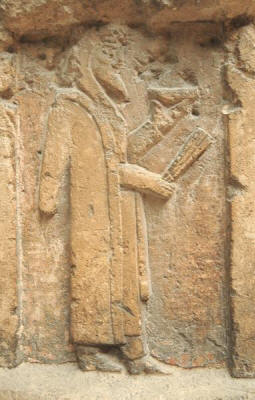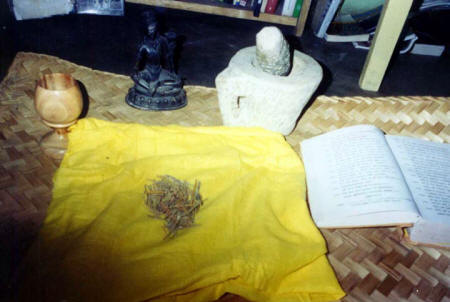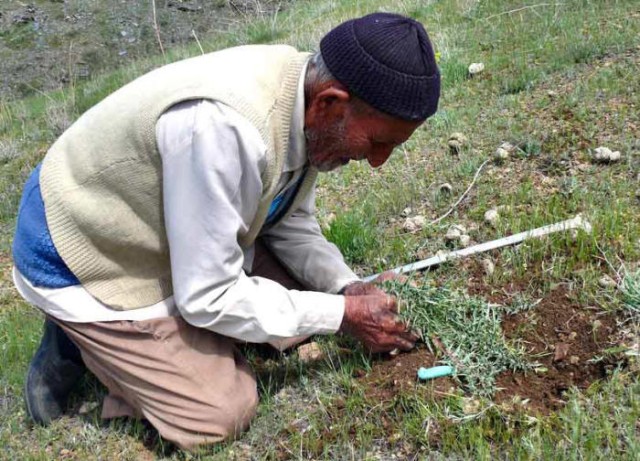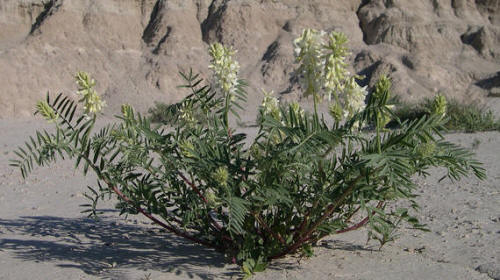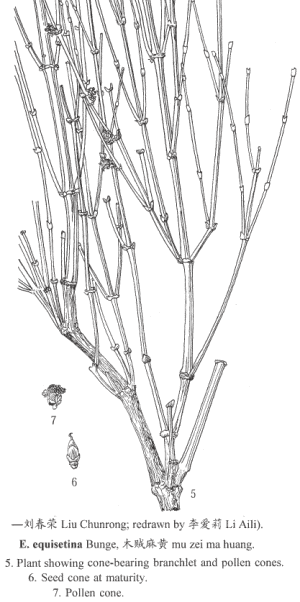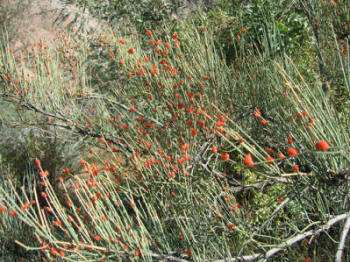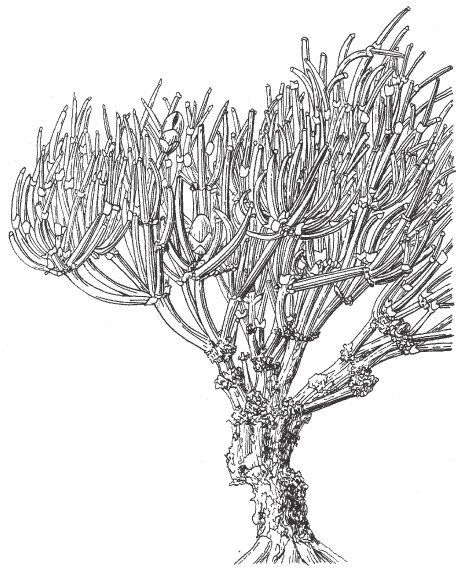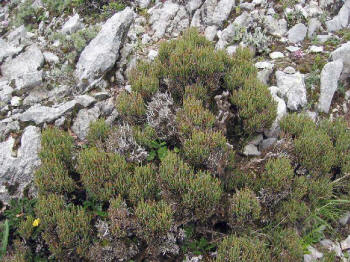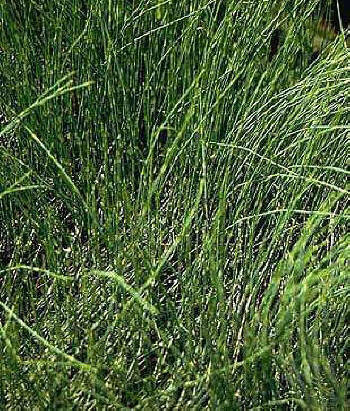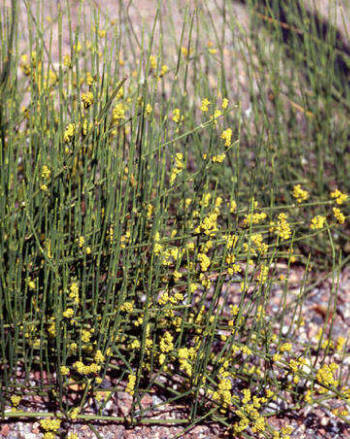
| HAOMA / HOM Introduction
:
In Zoroastrian texts, haoma is associated with the baresman (haomayo gava baresmana), a bundle of twigs from select medicinal plants and trees. The method of preparing the haoma extract is preserved in the principal Zoroastrian ritual called the yasna ceremony where the central rite is the ab-zohr, meaning strength to water. Two liquid extracts called parahom (from para-haoma meaning before-haoma) and hom are prepared during the rite. The first parahom extract is made by pounding of a mixture of three small twigs of ephedra (described below), one pomegranate (Av. hadanaepata) twig, pomegranate leaves and water. Cow's milk in Iran, or goat's milk in India, replaces water in a second preparation.
Only a few drops (see below) of the extract are consumed by the participants of the ceremony or by anyone else. Even the most beneficial of foods or cures can be harmful if consumed inappropriately or in excess. A guiding principle in Zoroastrian practices is to consume only that which promotes health, and only that which benefits both body and mind - while refraining from consuming anything (or quantities) that can cause harm.
The ritualistic practice of mixing and pounding together the ephedra and pomegranate twig and leaf to produce an extract preserves the process of synergistically bringing together the beneficial properties of the plants to promote physical health and healing. The ephedra and pomegranate extract is consumed as a mixture. The plants' extracts are not consumed alone or separately. In addition, bringing together plant life, water and animal milk while reciting a manthra, a prayer, promotes spiritual health as well.
In our discussion on the baresman, we see that pomegranate is one of several health promoting plants whose twigs make up the baresman bundle of twigs. The other baresman twigs we have been able to identify so far in the literature, are myrtle, laurel, pomegranate, tamarisk, willow and juniper (the texts say there are thousands of healing plants to treat thousands of aliments, the knowledge of which was destroyed with the destruction of Zoroastrian texts). The haoma twigs can be paired with different baresman twigs to produce blends with specific healing and health giving properties.
In ancient times, the haoma twigs were probably part of the baresman bundle.
Haoma and Baresman's Use in Ancient Health & Healing :
Rock
carving, Museum for Anatolian Civilizations, Ankara Zoroastrian scriptural texts (Vendidad 3.1 and 14.8, and Ram Yasht 5) mention that Zoroastrian priests carried with them the baresman, the mortar for pounding and extracting the twigs' juice, and cups. The image on the right appears to fit that description. It is a photograph of a relief rock carving that now resides in the Museum for Anatolian Civilizations in Ankara, Turkey.
Zoroastrian priests, the magi, were renowned physicians and healers. The magi's code of setting aside their personal needs in order to attend to a person in need of medical help, made the magi respected throughout the region.
The magi frequently carried the baresman bundle with them, so much so, that the baresman became the principle identifying symbol not just of the magi, but of the Zoroastrian faith as well.
Carrying a bundle of different twigs, the juices of which could be combined in different ways to treat a variety of different aliments, was in some ways the equivalent of carrying a modern-day physician's medicine bag.
Uniqueness of the Zoroastrian Method of Preparing Healing Extracts
:
Parahom Preparation Implements :
Nine-holed haoma strainer surakhdar tasjta The ritual implements used to produce parahom are the mortar (hawan) and pestle (dastag/abar-hawan/labo) for pounding and extracting the juice from the plant, a nine-holed strainer (surakhdar tasjta), and a bowl for holding the parahom.
A
priest who knows how to prepare various kinds of haoma extracts
and their benefit, is called a hawanan.
Haoma's
Identification in Scripture :
The following are further descriptions and references to haoma in the Hom Yasht, chapters 9 - 11 in the book of Yasna, a book that is part of the Zoroastrian scriptures, the Avesta :
Haoma's
Growing Range :
Haoma's
Characteristics :
Yasna 9.16 mentions the term asu in connection with haoma. Several translators of the Yasna describe asu as a characteristic of haoma and their conclusions are varied. Dieter Taillieu translates asu as twigs, Robert Wasson as stalks, Ilya Gershevitch as fibre or flesh, and Mills as sprouts. Asu could also mean finger-like joints, a characteristic used to describe the Hindu soma (see below), and which is termed ksip.
The term asu is also found in healing related inscriptions in tablets from the library of Assyrian King Ashurbanipal (668 - 627 BCE) at Nineveh. In these texts, translators feel that asu is the title for a specialist in herbal remedies.
Haoma's Properties :
Middle Persian Zoroastrian literature such as the Lesser Bundahishn 24.18 quoted above, point to haoma being the name of an eponymous healing plant that lent its name to a family of healing plants which appear to have been used in conjunction with the main haoma plant in the manner preserved by the ab-zohr ceremony described above.
Identification of Haoma :
Scriptural references tell us there were varieties of haoma with different colours, of which white haoma was a very special if not rare variety. The colour of ephedra stalks do change with variety, age and season. Ephedra equisetina does have whitish stalks. It is also possible that a white variety of ephedra is now extinct. The cut haoma stalks gradually change colour as well, becoming gold and then brown as it dries.
Some translations speak of a haoma tree. Ephedra gerardiana is tree-like.
Zoroastrian texts do tell us that there were various varieties of haoma. The various varieties that we profile below are all haoma candidates and in addition to being found in Iran, Pakistan, India and Nepal, they also grow in the Central Asian regions of Tajikistan and Afghanistan where Ancient Zoroastrianism - at the time of the writing of the Avesta - may have had its home.
Other Indo-Iranian Names for Haoma / Ephedra :
The Zoroastrian Yazdi (Central Iranian or Persian) name for ephedra is hum (hom) or Hom.
In Iran, ephedras are particularly abundant in the eastern provinces. Significantly, despite lack of Zoroastrian influence in Eastern Iran, Afghanistan, Pakistan and Tajikistan for nearly a thousand years following the Arab invasion, the local names for various ephedra varieties all stem from the words haoma - names such as hom (Central Iran, Afghanistan, Brahui, Pashtu), hum / huma (Afghanistan & Baluchistan), humb (Baluchistan), hum-e bandak (Afghanistan), oman (Pashtu, Waziristan), omeh (Pashtu), omah / umah (Baluchistan), um / umbar (Afghanistan & Kashmir), uma (Afghanistan & Baluchistan), (w)uman / unan (Tajikistan-Badakhshan, Afghanistan & Pashtu), uroman (Pashtu), xuma (Tajikistan-Zerafshan), yehma (Afghanistan) and yumana (Munjan / Qom), yumena (Yidga).
The root word for the local names for ephedra changes from Hom to soma as we move into the traditional Aryan lands of the upper Indus river, i.e. Hapta Hindu or upper Hind / Sind. Today, these areas form Nuristan / Kafiristan in North-Eastern Afghanistan and the eastern adjacent districts of Chitral and Gilgit in the far north of Pakistan. The Chitral and Gilgit districts lie south of the Afghanistan's Wakhan corridor and the Hundu Kush mountains - the natural and traditional border between the Iranian (Avestan) and Indian (Sanskrit) regions.
In Nuristan we find ephedra called soma, then sumani in Chitral and som in Gilgit. Moving southeast into Kashmir, we unexpectedly hear ephedra called um and umbar. However, still further east along the southern Himalayan slopes of Nepal ephedra is again called soma.
We discuss the Indian (Sanskrut) soma below.
Relationship of Haoma (Hom) to Soma :
Hindu Soma Yajna Ceremony The soma variety of ephedra (vulgaris / distachya) is used in Hindu ceremonies honouring the deva Indra, who in Hindu tradition, imbibed soma for strength and vigour in battle. The photograph on the left shows the Soma Yajna ceremony spread. The ephedra pieces can be seen on the sheet.
There are similarities of the traditional Soma Yajna rituals using ephedra with the Haoma (Hom) Yasna ceremony using ephedra, including the mortar and pestle and references to extraction through crushing using a mortar and pestle. These similarities indicate a consistency in the orthodox ritual with perhaps one difference - ephedra in Zoroastrian Yasna ritual is used together with pomegranate twigs and leaves. However, similarities in orthodox, original, use does not translate to similarities in use as the Zoroastrian and Hindu communities separated. There are significant differences in subsequent practice and there certainly no similarities between haoma and the wild speculation of the Soma ceremony using materials other than ephedra.
Speculation
About Soma & Haoma As a Hallucinogen :
In the Avesta, there is no indication whatsoever that haoma was a hallucinogenic drug, and there is not a single instance of it ever having been used as such in Zoroastrian religious practice. On account of its health giving benefits, traditional haoma extract was harmless enough that a newborn was given a few drops to drink (cf. J. J. Modi The Religious Ceremonies and Customs of the Parsees p.8) as part of a religious ceremony celebrating the child's birth. The mother also consumed the prepared haoma / hom juice as part of the ceremony.
This speculation of haoma's use a hallucinogenic drug is of modern western origin - promoted by certain writers who seek readership and notoriety through sensationalism rather than scholarship. In promoting their theories, these writers ignore the reality of actual Zoroastrian practice - as well as references in the Avesta and traditional religious texts (except when the meanings of words are skewed to help confirm a previous bias induced by the speculation and fantastic translations). Traditional Zoroastrian references exclusively point to haoma as part of a health and medicinal system. We hasten to add that not all western observations are speculative. Some responsible western researchers, largely ignored by their colleagues, have recorded Zoroastrian practice and tradition, and we note their observations below.
Early Western Observations :
"When travelling in 1879 between Bandar Abbas and Kerman, and at an altitude of over 7,000 ft. (over 2,100 m.), I was shown the hum (hereafter hom) shrub, from which the Parsis (hereafter Zoroastrians) of Persia get the juice hom or Hom, the Indian soma. ...growing to a height of four feet, and having circular fleshy stalks of whitish colour, with light brown streaks. The thickest stalks were about a finger thick; the leaves that fallen off as well as the flowers, which I was informed, were small and white; some seed adhered to the ends of some stalks... .The juice was milky, of a greenish white colour, and had a sweetish taste. The Zoroastrian who was with me, as well as others in Kerman and Yazd, told me that the juice turns sour after a few days, and that the colour of the juice, as well as that of the stalks, turns to a yellowish brown (cf. Yasna 11.3, regarding the mistake of keeping haoma and its spoiling)."
Collecting kangar (gundelia Tournefortii) in the mountains. Image credit: dynamosquito at Flickr "Of hom mixed with the juice of many (forty) plants, as mint, thyme, asparagus, kangar (gundelia Tournefortii - a mountain grass that is also cooked as a khoreshte i.e. cooked with sauce and spices) etc., the juice of seven fruits and the urine of a young pure cow, the purifying liquid nirang is prepared by the Zoroastrians. The priests drink a few drops of this every two or three days... and other Zoroastrians drink a few drops, never more than twelve or sixteen, daily during their Bareshnum time of purification. The liquid is also given as a remedy against sickness; a few drops are poured into the mouth of a newborn child, and into that of a dead person before carrying the body to the dakhma (towers of silence); when taken in greater quantities, that is more than twelve or sixteen drops, it is said to cause vomiting. The hom itself is used by Zoroastrians in their religious ceremonies."
Astragalus Racemosus "The plant is at present not very plentiful round about Kerman; and many shrubs are being cut by woodcutters when collecting firewood, it daily gets rarer. The mobeds of Kerman pay the woodcutters to preserve ten or twelve shrubs yearly. The plant is also found in the mountains near Yazd. ...The best plants - that is, those giving most juice - were, however, certainly only found on mountains, exactly like other Persian juice containing plants; for instance the astragalus (see image right), which is common all over Persia, contains more juice and exudes more gum (tragacanth) the higher it is found. The hom grows also in the plains, but it is stunted and contains little juice."
"Anquetil says it grows in Gilan, Mazandaran and Shirvan (cf. Firdowsi, relation of Afrasiab's fight with Hom in Azerbaijan). Spiegel says the Parsis of Bombay get their Hom from Kerman and send their priests there from time to time to get it."
* Educated in engineering at Leipzig University, Houtum-Schindler was recruited to Persia in 1868 by the Indo-European Telegraph Department. Eight years later he became an inspector-general of the Persian telegraph service, and acquired the honorary rank of general in the Persian army.
Modi Quoting Dr. Aitchison :
Periploca Aphylla "Dr. Aitchison, who accompanied the English Afghan Boundary Commission of 1885 as a Naturalist, and to whom I had sent for identification and inquiry in Afghanistan a few twigs of the Haoma plant used by the Indian Parsis in their ritual, with an account of the plant as given in the Avesta, said in his reply:— "The specimens you sent me are the twigs of a species Ephedra (Nat. order Gnetaceœ*). A species grows all over this country — Baluchistan, Afghanistan, Kashmir, and Western Tibet — which seems to be identical with the species received. This species is here, in all this country, called hum (pronounced as the English word whom, also huma). In Baluchistan, it as well as a totally distinct plant, Periploca aphylla** is called hum. It grows equally on exposed hills and valleys consisting of 'branches and sprigs,' one mass of upright twigs, each twig, if you notice, being made up of joints like the joints of the fingers. When covered with male flowers, the bush (from 1 to 2 feet) is golden coloured, and the twigs are more or less so. This plant has no leaves. It is all twigs and jointed. Amongst the Pathans of the Khyber Pass and all over that country the twigs are with water made into a decoction and employed very largely as a household remedy in sickness, and are considered as possessing health-giving and healing properties. Owing to a general likeness between the stiff rod-like growth, upright and erect of the two plants, in Baluchistan, the natives equally give both the same name. No one would mistake the jointed and true hum for the non-jointed falae hûm, Periploca. The latter does not exist here at all. The Ephedra here is only employed to mix with snuff, being first of all burnt. The ashes cause the snuff to be more irritating, whether applied as a sternutatory or to the upper gum under the front part of the lip as is the habit here... . Before your letter and specimens came, I had made up my mind that the Ephedra was the nearest to the 'Soma' plant that I had got to, but as it was stated that the Parsis employed the twigs of Periploca it rather put me out. Your specimens are all on my side."
* Gnetaceœ or Fam. Gnetaceoe used in conjunction with Ephedra vulgaris Rich.
** Periploca aphylla is recognized as a ephedra substitute in preparation of the Hom extract (cf. The Botany of the Afghan Delimitation Commission by James Edward Tierney Aitchison; The Indo-Aryans of Ancient South Asia: Language, Material Culture and Ethnicity by George Erdösy and Biographies of Words and the Home of the Aryas by Friedrich Max Müller, p. 241). The individuals quoted state that Periploca aphylla and ephedra look alike except when in bloom and that locals call the entire group of these plants that look alike ("with naked leafless stems and branches") - hom. Periploca aphylla grows to heights of 1,000 m. in areas with ephedra too can be found. Its fragrant flowers taste like raisins.
K.
F. Geldner & O. Stapf :
Harry Falk :
Ephedra :
Ephedra Equisetina The Zoroastrians of Yazd, Iran, use the ephedra plant, which they call hum or Hom, in religious ceremonies that require haoma. The Zoroastrians of India import ephedra from Yazd, as well as Ephedra procera from the Hari River valley in Afghanistan, when available, for use as haoma.
Ephedra is reputed to be the world's oldest medicine and has reportedly been found buried in a 60,000 year old Middle Eastern Neolithic grave in Shanidar (Iraqi Kurdistan; please see our page on the Cave Dwellers in Old Iran). If the plant was intentionally placed in the grave, that might indicate a familiarity with its health uses and that the people of that time may have ascribed to ephedra spiritual properties that could assist the dead. This is speculative. What we do know, is that in Zoroastrian texts the method of haoma preparation imparts to the extract spiritual properties in addition to its healing properties.
Ephedra has been used in this manner throughout the ancient world. Ephedra is found in southwest North America, where it and has been used by aboriginal peoples as traditional medicine. Ephedra sinica has been used for 5,000 years in traditional Chinese medicine. The Chinese also exported the plant to other lands as a medicine.
Ephedra's widespread use and consumption around the world is reflected in the various common names people have given the plant and its extracts. For instance, ephedra is called Mormon, Brigham, Desert, Squaw or Mexican tea among various other names.
Ephedra Varieties :
The varieties growing in an around Central Asia in general, and Tajikistan in particular, are of special interest to our examination of Zoroastrian heritage and customs, as this is where the plants described in the Zoroastrian scriptures, the Avesta, likely grew. The principle varieties that grow in this region are :
•
Ephedra ciliata :
•
Ephedra distachya :
•
Ephedra equisetina :
Ephedra equisetina •
Ephedra fedtschenkoae :
•
Ephedra gerardiana :
Ephedra gerardiana •
Ephedra intermedia :
Ephedra intermedia •
Ephedra pachyclada :
•
Ephedra procera :
Ephedra procera • Ephedra
przewalskii : • Ephedra regeliana : Growing elevation: 700-3,800 m Plant height: 8-15 cm habitat: rocky slopes, flood lands and sandy place Colour: dark green, later brown
Ephedra regeliana • Ephedra sinica :Also called ma huang locally growing elevation: 700 - 1,600 m Plant height: small to 40 cm Habitat: waste, sandy and desert-like places, plains and mountain slopes, mainly China Colour: dark green, later brown
Ephedra sinica • Ephedra
vulgaris/evulgaris/distachya :
Ephedra vulgaris/evulgaris/distachya Haoma's
Medicinal & Health Properties :
The haoma extracts using just the few barsom family of plants identified in these pages contain a host of chemicals and subtle variations that probably work together synergistically. We have described some of the known medicinal and health giving properties of the individual barsom plants (namely, myrtle, laurel, tamarisk, pomegranate, jujube, willow, juniper, chenar or plane, camel thorn, esfand or harmala) in our page on the barsom.
Many other traditions make a tea or consume a dried powder and it is possible that heat can change the chemical composition and thereby the extract's properties. They are the result of a few thousand years of experience and knowledge. The ancient magi were the doctors and physicians of their time and had probably developed a great deal of experience in these matters, knowledge that has not been recorded and is probably lost.
As we have noted earlier, only a very small amount of haoma extract is consumed in traditional Zoroastrian practice. Further, ephedra used is not used alone but with other plants and milk as well. The Zoroastrian age-old customs were designed to maximize the benefits, minimize the risks and develop synergistic blends with ephedra as the base component.
We describe the properties of ephedra below. There is no work done on determining the medicinal or health properties of possible haoma extracts.
Ephedra
Properties :
While the properties listed below are common properties, it appears that the ancients recognized that different ephedra varieties had different property sets, and that one variety in particular, white haoma, was a very special and rare variety. It is possible that variety is now extinct.
Ephedra's active chemical, ephedrine, is found in its stem bark, and forms part of the liquid extract that is released when the stems are pounded or crushed. It is significant that the ancients did not try and exclude the stem wood in order to increase the ephedrine content of the extract. [The plant's fruit or buds can be eaten raw and have a very mild sweet taste, though the fruit or buds of some varieties are reported to be poisonous.]
The common extract is used in herbal remedies as an anti-viral (particularly against influenza), a diaphoretic, a blood purifier, a diuretic and a tonic.
In addition, ephedra's extract has been used to treat colds, flu, coughing, wheezing, nasal congestion, fever, hay fever, chills, headaches, edema, hyperhydrosis, and bone pains.
Since Ephedrine acts quickly to reduce the swelling of the mucous membranes as well as dilating the bronchioles (bronchial vessels) in the lung by stimulating beta-andrenergic receptors. These properties help it to serve as an antispasmodic and as a treatment for asthma.
Ephedra acts as a stimulants by causing the release of adrenaline from the adrenal glands. Adrenaline effects the central nervous system.
Ephedra causes thermogenesis (increase heat production) in the body. This in turn causes the body to burn its fat and resulting in reduced body weight. Ephedra is aided in this weight reduction function by its property as an appetite suppressant and is therefore used in weight reduction programs. It is aided in this function by the consumption of caffeine.
Ephedra constricts the blood vessels and indirectly acts on sympathetic nerves resulting in a speeding up the of heart and nervous system. In ancient times these properties would have benefited soldiers going into battle by helping them to stay alert and aggressive over longer periods than normal. In modern times, Ephedrine has been used as a athletic performance enhancer though it is a banned substance for athletes in many internationally recognized sports.
Ephedra reportedly acts as a sexual stimulant - especially for women.
External applications include treating allergic skin irritations, insect bites and stings.
In addition to Ephedrine, other constituents of ephedra include calcium, phosphorus, proteins, flavones, saponins, tannins, and volatile oils. There is a possibility that the myriad chemicals associated with the ephedrine produce synergies that cannot be realized by consuming isolated Ephedrine or a synthetic substitute. Ephedra chemistry is examined at American Journal of Botany and Genetics and Molecular Research.
Unlike using isolated or synthetic ephedrine, using the plant, with its many constituents, judiciously and with care is far more effective and rarely gives rise to serious side-effects. This is true of most plant medicine and especially true of ephedra where other plant constituents help buffer or improve the actions of the main or active ingredient(s). Nevertheless, ephedra / ephedrine can be fatal or cause hyper-stimulation if taken in excess or incorrectly. (Warnings: See: Care Group, Drug Digest & Amazing Nature).
The roots and leaves are reported to have therapeutic effects that are almost the opposite of the stem. For instance, the root extract is hypotensive while the stem extract is hypertensive.
Source :
http://www.heritageinstitute.com/ |
